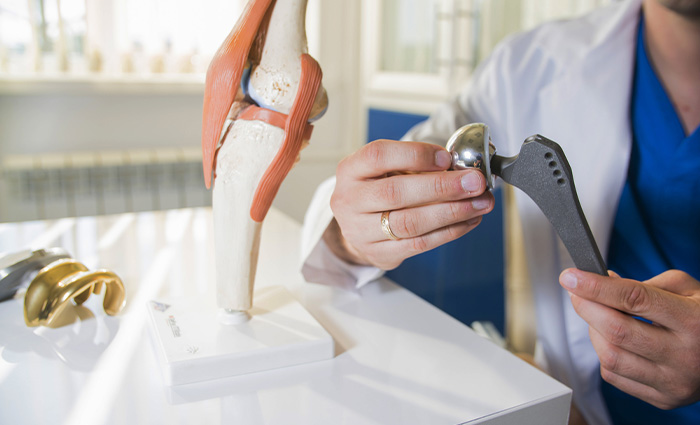Joint replacement surgery can help people who suffer from chronic pain and stiffness in their knees, hips, shoulders or ankles. One of the most common reasons for joint replacement surgery is when non-invasive treatments have not improved the condition. If your joint pain has kept you from being active, replacement surgery can eliminate your discomfort and improve your quality of life.
Normal joints move smoothly because they are coated with cartilage that acts as a shock absorber. When cartilage erodes over time or becomes damaged from a sudden injury, joints become inflamed and cause pain and stiffness. Damage can also develop gradually from overusing a joint during sports or a repetitive occupational activity.
Arthritis is a major contributor to joint pain and swelling with the potential to cause severe damage. There are several types of arthritis, including osteoarthritis, rheumatoid arthritis and psoriatic arthritis. Gout, bursitis and tendinitis can also contribute to joint pain.
Joint pain can be mild to debilitating, depending on the severity of the erosion of cartilage surrounding the bones. Symptoms can include swelling; stiffness; numbness; joints that crack, pop or grind in use; and difficulty bending or straightening out the joint. In severe cases, joints can become hot and swollen or even immobile. If this occurs, immediate medical attention is needed.
Are there treatments to try before joint replacement surgery?
An orthopaedic doctor will likely recommend other methods to reduce joint pain before suggesting replacement surgery. These treatments can include:
- Physical therapy to strengthen the muscles surrounding the joint
- Braces to support the knees or ankles
- Medications to alleviate pain
- Changes in activity levels to lessen stress on the joint
If these methods do not provide relief and the pain is limiting your everyday activities, joint replacement surgery may be your best option. The joint may be too compromised to respond to non-surgical treatments, and continued inflammation could cause more damage.
What should I know about joint replacement surgery?
Knee replacement surgery and hip replacement surgery are the two most common joint replacements. Several conditions can lead to needing a hip or knee replacement, but the biggest reason is that mobility is reduced when those joints are damaged. Sitting or lying down does not offer much relief once the condition has worsened. People who need a hip or knee replacement have difficulty walking, climbing stairs and sitting in chairs. Joint replacement surgery can also be performed on the shoulder or ankle.
Joint replacement is considered major surgery, but it is also one of the safest and most successful treatments for joint pain and disease. In the U.S., more than one million joint replacement surgeries are performed every year.
During surgery, an orthopaedic surgeon will remove worn cartilage in the area and replace the joint with an artificial joint made of metal or heavy-duty plastic. The prosthetic joint will look and act like a natural joint. You will be able to leave the hospital a few days after surgery and be on the road to a pain-free life again.
Is joint replacement surgery right for you?
Joint replacement is a major surgery that will require up to six months of recovery time. Before you decide, talk to your doctor about your options. If you have severe chronic pain that has not improved with other treatments, or if your condition is worsening, joint replacement surgery may be the best choice. You do not have to live with constant pain and immobility issues that interfere with your daily life.
Schedule a consultation with one of our orthopaedic doctors to discuss the surgery procedure and outcomes. Here are a few questions to ask:
- Will waiting make it worse?
- Is there anything I can try before surgery?
- What are the potential complications?
- What can I do to ensure a successful surgery and recovery?
- How long will I be in the hospital?
- How long will it take for me to recover?
Advancements in joint replacement
Joint replacement surgery has come a long way since it was first introduced 60 years ago. Surgery is less painful and invasive, and recovery is quicker thanks to new technology. Learn more in the blog “6 Myths About Joint Replacement.”
CT and MRI technology allows doctors to get 3D scans of the joint to see where they will need to make an incision to avoid disrupting surrounding muscles, ligaments and tendons. The 3D imaging can also help create a mold of the joint they are replacing. During surgery, doctors can be more precise with the help of computers that aid them in navigating through the joint.
The quality of replacement joints has also improved. Prosthetic joints are created with more durable materials that have a longer life span to avoid having to undergo surgery again within a few years.
In addition to technological advances, pain management and rehabilitation options have made recovering from joint replacement surgery easier for most patients. Depending on which joint is being replaced, the recovery process can take up to six months. Many patients consider it a small investment toward living pain-free for years to come.
Joint replacement surgery in Cary and Raleigh
If you are experiencing chronic pain in your hip, knee, shoulder or ankle, call the specialists at Cary Orthopaedics to discuss your options and to see if you are a candidate for joint replacement surgery. Our doctors are highly trained orthopaedic specialists with years of experience helping patients return to a pain-free and active lifestyle.






